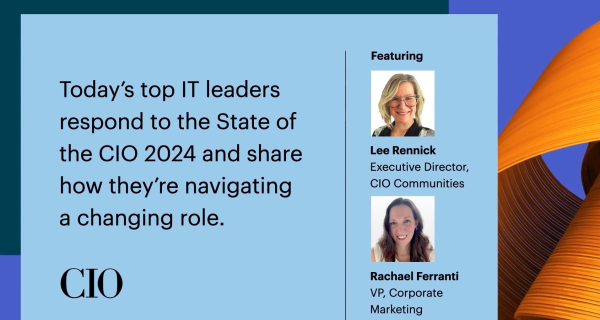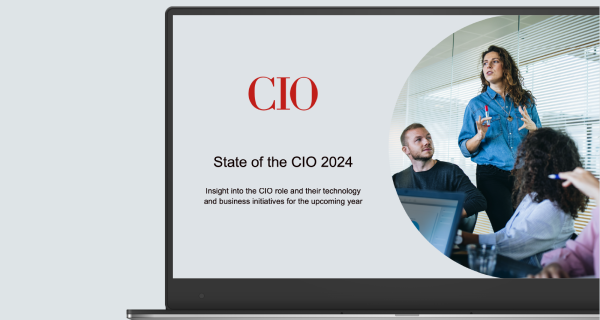It came as no surprise when we released the 2024 State of the CIO that artificial intelligence loomed large on the CIO’s radar this year. In fact, with 80% of CIOs citing AI as their number one area of involvement this year (up from 55% in 2023), it’s toppled security from the top spot for areas that the CIO is being pulled into. (Hint: that doesn’t mean cybersecurity isn’t still consuming a major amount of the CIO’s time—we address how they’re balancing these priorities here.)
I had lots of questions for Lee Rennick, Executive Director of CIO Communities at Foundry, on how CIOs are perceiving and preparing for an AI-heavy infrastructure in record time. During our conversation on how the findings of the 2024 State of the CIO were playing out in real CIOs’ day-to-day, we talked about the mixed feelings that they were having around bringing AI into the enterprise.
While Lee noted that many companies have been using AI for years, she spoke to the Generative AI phenomenon that we all experienced in 2023 as catalyzing a “democratization of AI” that stirred feelings of both excitement and hesitation at the tech leadership level. This tracked with some of the findings from Foundry’s inaugural AI Priorities Study, released in October of 2023, that found 1 in 4 tech leaders thought their organization was moving too quickly to deploy AI, and only 36% felt their data infrastructure was properly organized to enable AI in an effective way.
A fundamental reset to the roadmap

Like the internet changed the way everything is done, so will AI. It’s time to rethink the vision, strategy, and roadmap, and it’s not an incremental reset—it’s a fundamental reset.
To better understand how CIOs and senior tech leaders were tempering their own enthusiasm and cross-departmental pressure to implement AI tools with cautionary discretion, we looked to two of her CIO Leadership Live interviews.
In the first, Raji Subramanian, CTO of Opendoor, spoke with Lee about the possibilities for industry reinvention and disruption that AI will enable. Noting that Opendoor has embraced AI and machine learning (ML) to rethink everything from productivity and customer experience to the fundamentals of the real estate industry, Raji urges technology leaders to do the same. “It’s easy to get complacent,” she says, “but this is the time to reset.”
“Like the internet changed the way everything is done,” says Raji, “so too will AI. It’s time to rethink the vision, strategy, and roadmap. And this is not an incremental reset, it’s a fundamental reset.”
Advocating for data quality and due diligence

Right now, every niche vendor seems to have LLMs. I’d encourage peers to be eyes wide open. What have they really built before they sell it to you at a premium?
While many CIOs, CTOs, and other tech leaders share Raji’s enthusiasm for AI and the possibilities it will bring, there is an undercurrent of caution and even apprehension amongst this same group surrounding the flood of new AI tools on the market. Lee’s February 2024 interview with Graham O’Sullivan, CIO of OneFamily, touched on some of the common concerns that tech leaders are facing.
Graham highlights three key areas that he’s evaluating as AI infiltrates the enterprise. The first are considerations related to large language model (LLM) training, the content being output by these models, and the “appropriateness” of generated content designed for customer-facing applications. His second consideration is around data quality, noting that while data quality initiatives have been a major focus for years, AI is bringing a new sense of urgency around data hygiene to IT leaders being asked to implement these solutions.
Third, Graham expresses concern around the AI solutions being sold themselves. “If you go to a conference right now, every niche vendor seems to have LLMs,” he says. But noting that this technology is still relatively new to market, “there’s a degree of [vendors] rushing in to say ‘we have something.’”
In this landscape, Graham urges his peers to be “eyes wide open” in evaluating solutions. He says to ask of vendors, “what have they really built before they sell it to you at a premium”—is it truly sound and proprietary, or have they “wrapped one of these enterprise services in branding and content, and now the hard work begins in terms of safety, data quality, and how you implement it in your environment?”
Vendor responsibility in the age of AI
Though Raji and Graham’s interviews had different tones to them, the reality is that most CIOs and tech leaders find themselves on both sides of the fence when it comes to AI—they’re simultaneously excited about its potential to innovate and disrupt industries, while at the same time aware of the pitfalls of adopting this technology too early, or of being misled by branding and white labeling.
In this light, the responsibility of vendors is enormous at this moment. As Lee and I wrapped up this segment, she stresses that organizations are still not out of the woods when it comes to modernizing legacy systems—a prerequisite for enabling AI effectively. For these IT leaders “dealing with legacy systems, looking at how to effectively move data into the cloud, and looking at public versus private cloud and hybrid options… there are still a lot of those discussions going on—and that’s where so many of them are requiring support from their vendors,” Lee says.
“The new overlay on all of that is Generative AI,” Lee continued. “Now [these IT leaders] really do need to have all of that in order, know what the strategy is, and start putting that into place so they can move to this next task which is creating better efficiencies, not just for their company but for their customers.”
There’s a key takeaway here for tech vendors, both within and outside of the AI space. As CIOs are being asked to quickly implement AI solutions, many also know that their existing data and infrastructure need an overhaul first for these solutions to benefit them. They’re excited about the future, but don’t mistake their excitement as falling victim to the AI hype. Now is the time to deliver value in the form of guidance, education, and personalized support. AI has positioned the CIO to lead their organization through a new vision for the future, and only trusted vendors will be asked to join them along their journey.
To learn more about how tech marketers can support CIO in the age of AI, check out the rest of this video series, and download the 2024 State of the CIO today.




